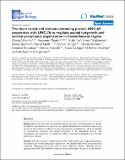The short coiled-coil domain-containing protein UNC-69 cooperates with UNC-76 to regulate axonal outgrowth and normal presynaptic organization in Caenorhabditis elegans
Author(s)
Su, Cheng-Wen; Tharin, Suzanne; Jin, Yishi; Wightman, Bruce; Spector, Mona; Meili, David; Tsung, Nancy; Rhiner, Christa; Bourikas, Dimitris; Stoeckli, Esther; Garriga, Gian; Hengartner, Michael O; Horvitz, Howard Robert; ... Show more Show less
Downloadjbiol39.pdf (2.258Mb)
PUBLISHER_CC
Publisher with Creative Commons License
Creative Commons Attribution
Terms of use
Metadata
Show full item recordAbstract
Background: The nematode Caenorhabditis elegans has been used extensively to identify the genetic requirements for proper nervous system development and function. Key to this process is the direction of vesicles to the growing axons and dendrites, which is required for growth-cone extension and synapse formation in the developing neurons. The contribution and mechanism of membrane traffic in neuronal development are not fully understood, however. Results: We show that the C. elegans gene unc-69 is required for axon outgrowth, guidance, fasciculation and normal presynaptic organization. We identify UNC-69 as an evolutionarily conserved 108-amino-acid protein with a short coiled-coil domain. UNC-69 interacts physically with UNC-76, mutations in which produce similar defects to loss of unc-69 function. In addition, a weak reduction-of-function allele, unc-69(ju69), preferentially causes mislocalization of the synaptic vesicle marker synaptobrevin. UNC-69 and UNC-76 colocalize as puncta in neuronal processes and cooperate to regulate axon extension and synapse formation. The chicken UNC-69 homolog is highly expressed in the developing central nervous system, and its inactivation by RNA interference leads to axon guidance defects. Conclusion: We have identified a novel protein complex, composed of UNC-69 and UNC-76, which promotes axonal growth and normal presynaptic organization in C. elegans. As both proteins are conserved through evolution, we suggest that the mammalian homologs of UNC-69 and UNC-76 (SCOCO and FEZ, respectively) may function similarly.
Date issued
2006-05Department
Massachusetts Institute of Technology. Department of BiologyJournal
Journal of Biology
Publisher
BioMed Central Ltd
Citation
Journal of Biology. 2006 May 25;5(4):9
Version: Final published version
ISSN
1475-4924